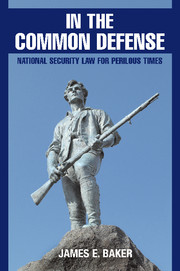Book contents
- Frontmatter
- Contents
- Acknowledgments
- Abbreviations
- Introduction
- 1 Perilous Times: Describing the Threat
- 2 The Meaning of National Security
- 3 National Security Law
- 4 Constitutional Framework
- 5 Electronic Surveillance: Constitutional Law Applied
- 6 National Security Process
- 7 Intelligence
- 8 Use of Military Force
- 9 Homeland Security
- 10 The National Security Lawyer
- Attachments
- Notes
- Index
10 - The National Security Lawyer
Published online by Cambridge University Press: 26 July 2009
- Frontmatter
- Contents
- Acknowledgments
- Abbreviations
- Introduction
- 1 Perilous Times: Describing the Threat
- 2 The Meaning of National Security
- 3 National Security Law
- 4 Constitutional Framework
- 5 Electronic Surveillance: Constitutional Law Applied
- 6 National Security Process
- 7 Intelligence
- 8 Use of Military Force
- 9 Homeland Security
- 10 The National Security Lawyer
- Attachments
- Notes
- Index
Summary
This book has considered national security law and process in the context of four security threats. First is the threat of attack by nonstate and state-sponsored or supported actors using terrorist means. Overseas, this threat is realized on a daily basis. Within the United States the threat is continuous, but intermittent. The threat of high-explosive attack, like car and truck bombs, targeted suicide bombings, or the sabotage of aircraft, is most likely to materialize. The threat of catastrophic attack with nuclear weapons has the greatest potential impact on our way of life and in terms of human cost. It is in relation to this threat in particular that we need to evaluate and test national security law and process, both because of the potential consequence and because of the focus the enemy has placed on this means of attack.
Second, U.S. constitutional values may ebb and wane in an endless conflict against state and nonstate actors engaged in acts of terrorism or posing the threat of terrorism. In light of the interminable nature of this threat, assertions of presidential authority made in extremis may become embedded in U.S. practice and law without a corresponding application of checks and balances. Left outside the reach of effective and independent mechanisms of appraisal, broad assertions of executive authority may in time diminish both the principles of law that define American life as well as the physical security at which they are directed.
- Type
- Chapter
- Information
- In the Common DefenseNational Security Law for Perilous Times, pp. 307 - 326Publisher: Cambridge University PressPrint publication year: 2007



